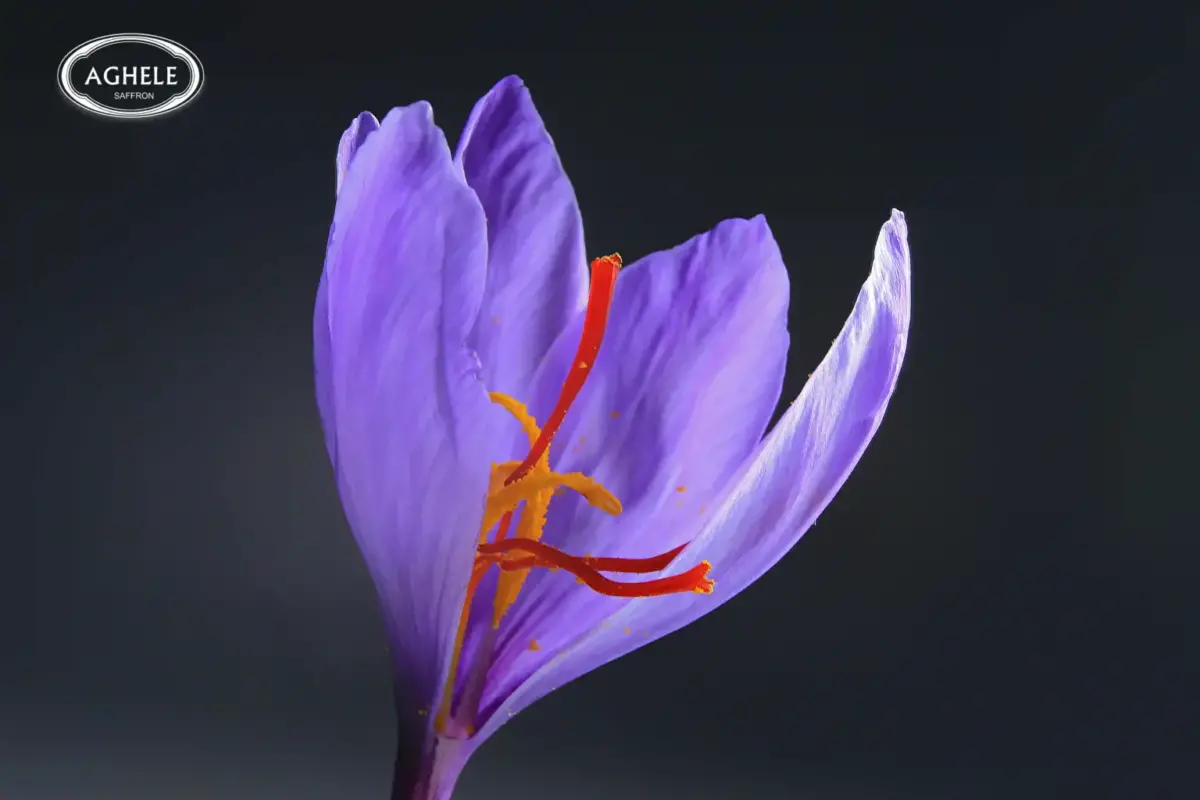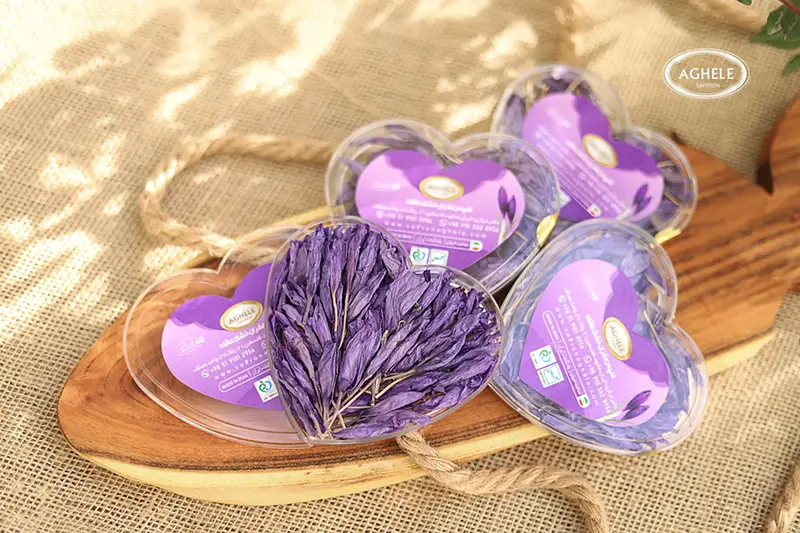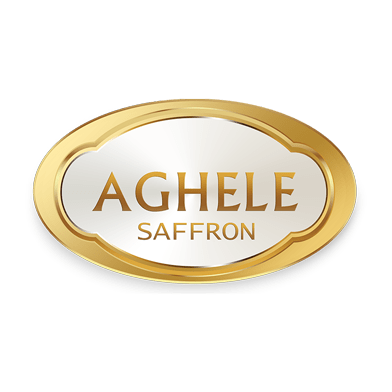Saffron, with its taste, aroma, and beautiful red threads, has captivated people for centuries. However, little attention is often paid to the delicate purple petals surrounding the precious threads. In this article, we will explore the uses and properties of saffron’s purple petals. Before purchasing saffron, it’s advisable to check its price. At Aghele, we update saffron price daily on our website, so you can stay informed about the latest prices.
Understanding the Saffron Flower
Known as the “king of spices,” saffron has a rich history dating back thousands of years. Each saffron flower has three red stigmas delicately attached to the purple petals. The purple color of the saffron petals is due to various natural compounds, with anthocyanins playing a key role. Anthocyanins are pigments found in plants that give them their purple or blue hue. In saffron, these compounds help the purple petals enclose the valuable stigmas.
What Part of the Saffron Flower is Referred to as Saffron?
The saffron flower, scientifically known as *Crocus sativus*, is recognized for its economic value and wide range of uses in the food, pharmaceutical, and cosmetic industries. The flower consists of several parts, but the part referred to as “saffron” and used commercially is the red stigma, which you’ve likely seen before. These stigmas are actually three long, narrow threads located in the center of the saffron flower. They are famous for their distinct color, aroma, and flavor, making them highly popular among people, especially chefs.
The stigmas of saffron are harvested from the flower and, after being dried, are sold as a valuable and expensive spice. There are various methods for drying saffron, and if not dried properly, it can become moldy and spoiled. The method of cleaning the saffron flower is also crucial and can significantly affect the final product’s quality. This part of the saffron plant contains active compounds such as crocin, picrocrocin, and safranal, which give saffron its unique medicinal properties and coloring ability. For this reason, saffron is known as one of the most expensive spices in the world and holds a special place in many cultures and kitchens. As you may know, dishes such as tahchin, zereshk polo, desserts like sholeh zard and majoon, and drinks like saffron syrup are popular Iranian foods that use saffron.
In addition to the stigmas, the saffron flower consists of other parts like purple petals and other plant components, though these are usually not used to produce saffron. Saffron petals are sometimes utilized as decorative edibles or in traditional medicine, but their economic value and primary use are less significant compared to the stigmas.
During the saffron harvesting process, farmers must carefully separate the stigmas from the saffron flower and immediately dry them to preserve their quality and properties. This labor-intensive and costly process is one of the main reasons for saffron’s high price. For this reason, saffron is recognized as one of the most expensive and valuable spices in the world. You can observe the beautiful color of saffron petals in the image below.

What Are the Benefits of Saffron Petals?
Besides their beauty and striking color, saffron petals have multiple properties that have garnered attention in both traditional medicine and modern scientific research. These petals, usually purple or violet-blue, were often considered waste during the saffron harvesting process in the past. However, due to extensive research conducted in recent years, this part of the saffron flower has also demonstrated medicinal and nutritional values.
Improving Digestive Health with Saffron Petals:
Saffron petals aid in digestion and nutrient absorption, thus helping the digestive system function better. Good digestion prevents stomachaches and bloating. Additionally, it helps maintain a normal appetite, preventing issues like overeating or lack of appetite. These effects are due to the petals’ calming and anti-inflammatory properties, which can alleviate symptoms of digestive disorders.
Menstrual Relief with Saffron Petals:
If you experience painful periods, it is recommended to use saffron petals two to three days before your period to reduce pain and have a more comfortable menstruation. Due to their anti-inflammatory properties, saffron petals can be effective in relieving menstrual pain.
Antibacterial Properties of Saffron’s Purple Petals:
Everyone may ingest bacteria through food or drink. One benefit of saffron’s purple petals is their ability to protect the body against these bacteria. Additionally, saffron petals have antioxidant properties, which are beneficial for overall health.
Read more: The Effects of Saffron on Menstruation
Respiratory Health and Asthma Relief with Saffron Petals:
One of the elements found in saffron petals is zinc, which helps improve respiratory function. It also aids in the treatment of respiratory conditions such as asthma and bronchitis. If you or someone close to you suffers from asthma, you might be aware that occasional attacks can occur. Consuming saffron petals may help reduce the frequency of asthma attacks.
Weight Loss with Saffron’s Purple Petals:
The enzymes and compounds found in saffron petals promote fat burning, which leads to weight loss. This is one of the key benefits of saffron petals.
Liver Detoxification:
The liver is one of the body’s vital organs, responsible for detoxification. Antioxidants, including those found in saffron petals, support liver function and enhance its ability to detoxify the body.
Sleep Regulation:
With the beneficial compounds found in saffron petals, drinking an infusion of saffron’s purple petals can help regulate sleep and improve sleep disorders.
Antidepressant Properties of Saffron Petals:
The compounds found in saffron petals can have a positive effect on the nervous system and help reduce symptoms of depression. Studies have shown that consuming saffron petal tea can have calming effects, reducing anxiety and daily stress. This benefit is due to the presence of compounds such as flavonoids and anthocyanins in saffron petals, which support better brain function and uplift mood.
Antioxidant Properties of Saffron Petals:
Antioxidants are beneficial compounds that protect the body from cellular damage. These compounds can reduce the risk of diseases such as heart disease, cancer, and diabetes. Regular consumption of saffron petals, either as an herbal tea or an ingredient in meals, can improve overall health.”
Anti-inflammatory Properties of Saffron Petals:
Saffron petals can help reduce inflammation in the body and alleviate pain associated with inflammatory conditions, such as joint and muscle pain. Flavonoids and phenolic compounds are responsible for the anti-inflammatory effects found in saffron petals.
Boosting the Immune System with Saffron Petals:
Rich in vitamins, minerals, and various antioxidants, saffron petals can strengthen the immune system and make the body more resistant to infections and illnesses. Therefore, regular consumption of saffron petal tea can contribute to enhancing your immune system.
Anti-Cancer Properties of Saffron Petals:
Research has shown that certain compounds in saffron petals may help reduce the growth of cancer cells and prevent some types of cancer. Although this property requires further research for full confirmation, the initial findings are quite promising.

Saffron Flowers in the Cosmetic Industry:
Saffron petal extract is used in the production of creams, lotions, and skincare products due to its anti-aging properties. These products can improve skin condition, reduce wrinkles, and increase the softness and smoothness of the skin.
Blood Pressure Reduction with Saffron Petals:
Consuming saffron petal tea can help lower blood pressure and reduce the risk of cardiovascular diseases. This benefit stems from the calming and anti-stress compounds in saffron petals, which help relax blood vessels and lower blood pressure.
In addition, saffron petals are also used as a natural additive in foods. These petals can be added as a natural flavoring and coloring agent, enhancing the nutritional value of dishes while providing additional health benefits to consumers.
Uses of Saffron’s Purple Petals:
You can make a variety of delicious and flavorful herbal teas using saffron’s purple petals, enjoying both their taste and health benefits. At the Aghele Saffron website, we offer saffron petals for sale, and with just a click, you can view the price of purple saffron petals and proceed with your purchase.
Saffron’s purple petals have garnered attention for their medicinal and nutritional properties. While the primary part of saffron is its red stigmas, known for being a precious and aromatic spice, the purple petals also offer numerous benefits and applications that should not be overlooked.
Saffron Petal Herbal Tea:
One of the primary uses of saffron’s purple petals is in preparing herbal teas. These teas are highly regarded for their calming and anti-anxiety effects. After a busy day, you can make a saffron petal tea at home to relax and enjoy its benefits.
Moreover, saffron petals contain powerful antioxidants that help reduce inflammation and improve immune system function. Saffron petal tea is often combined with other medicinal herbs like chamomile and mint to enhance its therapeutic effects.
Cosmetic Industry Applications of Saffron Petals:
In addition to their use in herbal teas, saffron’s purple petals are also utilized in the cosmetic and skincare industries. Due to their nutrient content and vitamins, these petals are incorporated into natural ingredients used to produce creams, facial masks, and skincare products. Saffron petals help reduce skin inflammation and repair damaged tissue, making them a key ingredient in many anti-aging and rejuvenating products.
Saffron Petals as a Natural Food Dye:
Saffron’s purple petals are also used as a natural dye in the food and pharmaceutical industries. These petals can add unique color and flavor to foods and beverages without the need for artificial colorants. In the pharmaceutical industry, saffron petals are used as a natural component in the production of capsules and dietary supplements.
Traditional Medicine Uses of Saffron Petals:
In some cultures, saffron’s purple petals are used in traditional remedies and local medicines. These petals are considered a natural treatment for headaches, fatigue, and insomnia. Given all these applications, it’s clear that saffron petals have significant potential and should not be regarded merely as waste in the saffron harvesting process.
Culinary Uses:
Saffron petals can also be used in a variety of dishes and desserts. Adding these petals enhances the fragrance and flavor of your meals, and they can also serve as a decorative element. One delicious treat you can make with saffron petals is saffron flower jam, for which we’ve provided a recipe.
Beverage Applications:
Saffron petals are suitable for both summer cold drinks and winter warm beverages. Many cafés use saffron petals to garnish their drinks, adding both beauty and flavor.
Final Thoughts:
In this article, we aimed to discuss the properties and benefits of saffron’s purple petals. You can use this product in foods, desserts, drinks, and herbal teas. Saffron petals can help regulate sleep, improve liver function, and offer antioxidant benefits.

